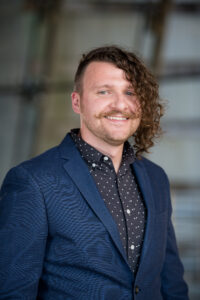
Alejo Benedetti during a tour of “Men of Steel, Women of Wonder,” organized by Benedetti and presented at Crystal Bridges in 2019. Photo by Stephen Ironside, Courtesy of Crystal Bridges.
The Shaping the Arts series highlights TCU College of Fine Arts faculty and alums who are at the forefront of their field and Lead On, Creatively.
We spoke to School of Art alumnus Alejo Benedetti ’15 about curating and collaborating with prolific portrait photographer Annie Leibovitz for the “Annie Leibovitz at Work” exhibition at the Crystal Bridges Museum of American Art in Bentonville, Arkansas.
“Working with Annie Leibovitz is always interesting,” said Benedetti. “It was a little surreal because she is a living legend.”
A Keen Eye
“Annie is a prolific American photographer with a keen eye, documenting our popular culture landscape for over half a century.”
“Annie Leibovitz at Work” showcases 25 newly commissioned pieces, marking Leibovitz’s first museum venture in nearly a decade, alongside iconic images from her storied career.
“She was very clear from the outset that she didn’t want it to be retrospective, and we wanted to respect that and worked with her to create something unique,” explained Benedetti. “She was really interested in creating conversations, crisscrossing her career from her earliest works in 1968 when she first got a camera to the present moment.”
Benedetti collaborated closely with Leibovitz to transform the museum into an immersive exhibition spanning five rooms. Each photo sparks a conversation, and every room reveals carefully placed callbacks and Easter eggs to different works.
“Annie was less interested in the moment the photo was taken and more focused on working across that chronology, drawing on different ideas and individuals she’s photographed to set up conversations in interesting ways.”
The exhibition begins with smaller black-and-white photographs taken during her time at Rolling Stone and culminates in giant digital screens showcasing both contemporary and archival work. The exhibition features around 300 printed photos and an additional 300 on the screens.
“As we approach the final room, we want to ensure visitors feel we’ve taken them along for the ride and helped them understand how we are reaching this point in the conversation.”
Career at the Crystal Bridges Museum of American Art

Alejo Benedetti, courtesy of Crystal Bridges.
“I was excited about TCU and the School of Art’s connections with local museums,” said Benedetti. “The opportunity to work with the late Frances Jean Colpitt, art history professor emeritus and former Deedie Potter Rose Chair of Art History, was a big selling point; she was an absolute rockstar.”
After earning his master’s in art history, Benedetti applied for a curatorial assistant position at the Crystal Bridges Museum, and within eight years, he progressed to the role of curator of contemporary art.
The Crystal Bridges Museum celebrates the American spirit, and Benedetti aspires to include artists who challenge visitors to contemplate this in exciting and diverse ways.
“What I love about my job is collaborating with contemporary and living artists. This gives me the opportunity to adapt my working style and glean new information and approaches from the artists themselves.”
Q&A with Benedetti
In what way do you anticipate the 25 commissioned pieces contributing to the museum’s collection?
Benedetti: We always contemplate how the artworks in our collection can convey different stories. One of the things Annie does exceedingly well is narrating stories through both the composition and who she has photographed. Thinking about how to put these in conversations is very interesting.
As exciting as the exhibition is, there is also something tremendously exciting about putting these photos in our permanent collection galleries and thinking about what other stories we can tell in the future.
What guidance would you offer students aspiring to pursue a curatorial career?
Benedetti: The number one thing is to become an art fan. I often describe myself as a curator with the enthusiasm of an art fanboy in khakis. I continue to be excited about the artworks I encounter, engaging in discussions and writing about them. Beyond appreciating art, it’s so important to be able to discuss and write about the pieces. To think deeply about how these artworks are functioning and what stories the artists are conveying is essential. Ensure that the artwork and the artist remain the central focus guiding your curatorial work.
